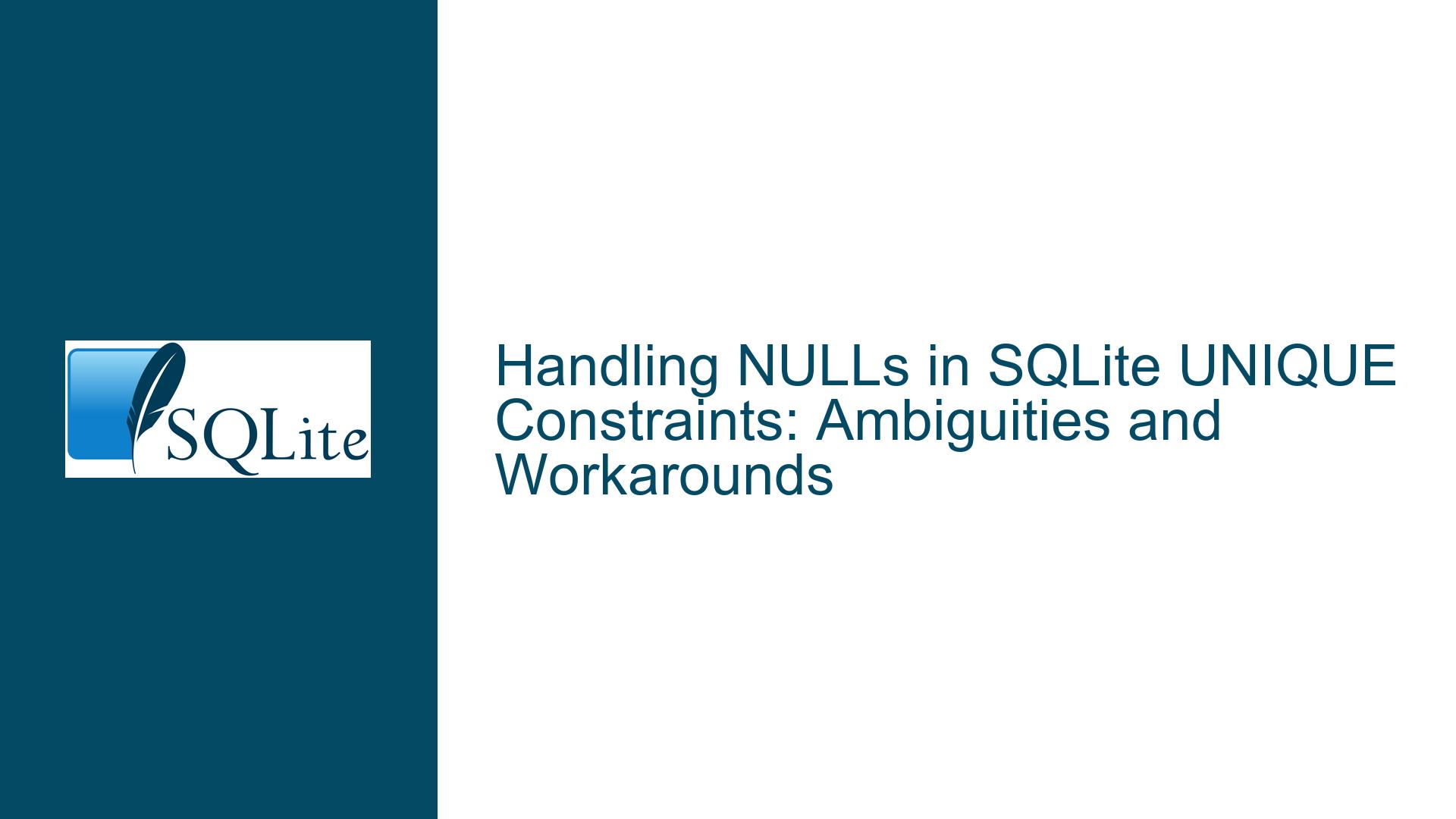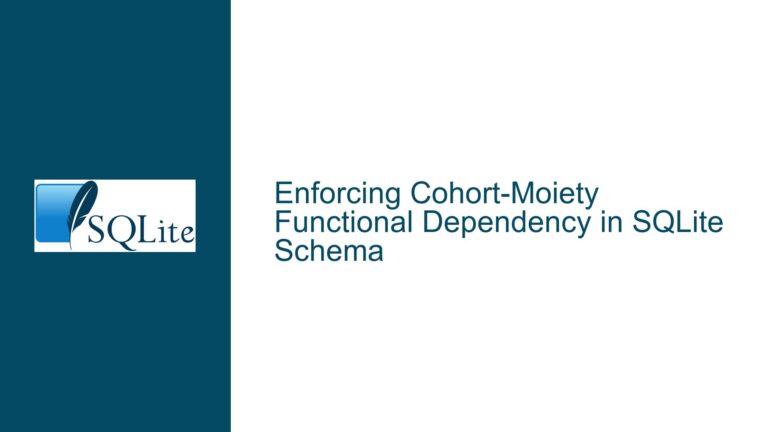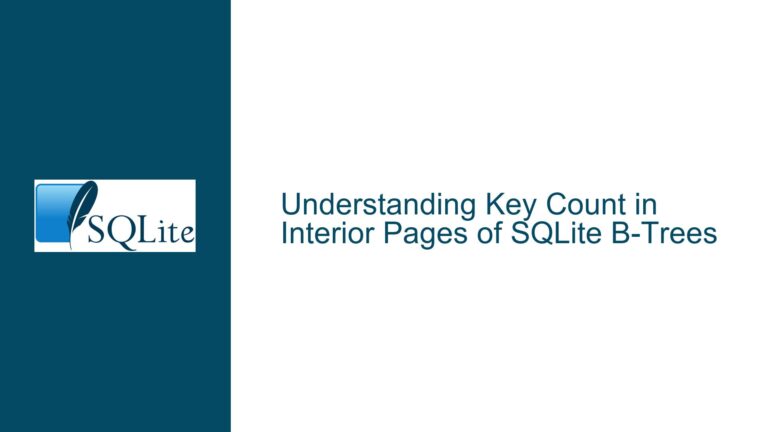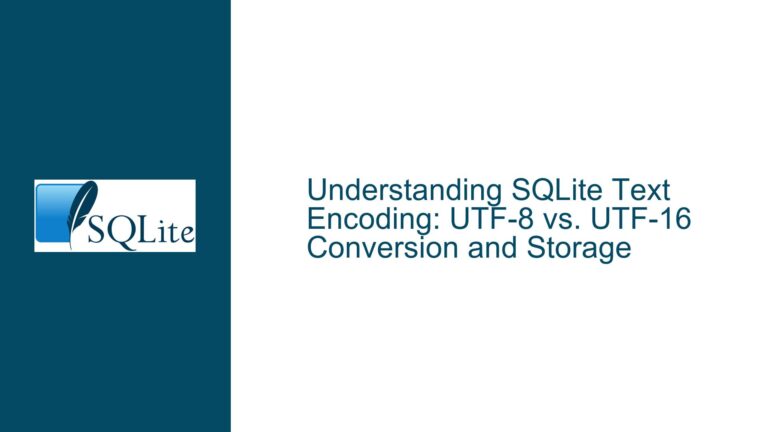Handling NULLs in SQLite UNIQUE Constraints: Ambiguities and Workarounds
PostgreSQL’s UNIQUE NULLS NOT DISTINCT and Its Implications for SQLite
The handling of NULL values in UNIQUE constraints has long been a source of ambiguity in SQL implementations. While PostgreSQL 15 introduced the UNIQUE NULLS NOT DISTINCT clause to treat NULL as non-distinct values in unique constraints and indexes, SQLite’s current behavior diverges from this approach. In SQLite, NULL values are treated as distinct for the purposes of uniqueness checks, meaning multiple NULL entries in a column with a UNIQUE constraint are permitted. This discrepancy raises critical questions for developers migrating from PostgreSQL or designing schemas that rely on strict uniqueness semantics involving NULL.
The core issue revolves around how NULL—a marker for missing or inapplicable data—should interact with uniqueness guarantees. For example, consider a table where rows represent documents, and each document must have a unique name under a specific parent document. If the parent is NULL (indicating a top-level document), the current SQLite behavior allows multiple top-level documents with the same name, violating the intended uniqueness requirement. This problem extends to other domains, such as user accounts with optional email addresses or product catalogs with partially unique identifiers. The absence of a mechanism to enforce uniqueness in the presence of NULL creates data integrity risks that developers must address through alternative means.
The SQL specification leaves the treatment of NULL in unique constraints undefined, leading to implementation-specific behaviors. SQLite’s documentation explicitly states that NULL values are considered distinct, but this design choice may not align with application requirements. Developers seeking parity with PostgreSQL’s new behavior or stricter uniqueness guarantees face a gap in SQLite’s feature set. This section explores the technical foundations of the problem, including SQLite’s indexing mechanics, the semantics of NULL, and practical scenarios where the default behavior falls short.
Common Use Cases Challenged by SQLite’s Current UNIQUE NULL Handling
Document Hierarchies with Top-Level Uniqueness
A recurring example involves hierarchical data structures, such as documents or folders, where uniqueness must be enforced at each level of the hierarchy. Suppose a docs table includes columns parent_id (foreign key referencing the same table) and name. Top-level documents have parent_id set to NULL, and the requirement is that no two top-level documents share the same name. Under SQLite’s default behavior, inserting multiple rows with name = 'Report' and parent_id = NULL is permitted, violating the intended constraint. This flaw undermines data integrity in applications relying on hierarchical uniqueness.
Optional Unique Fields with Partial Enforcement
Another scenario involves fields that are optional but must be unique when populated. For instance, a users table might allow email to be NULL (for users who haven’t provided an email) but require uniqueness among non-NULL values. SQLite’s UNIQUE constraint fails to enforce this because it allows multiple NULL entries. Similarly, in inventory systems, a products table might have a sku column that is optional for custom items but unique when assigned. Without a workaround, duplicate sku values could slip through if some entries are NULL.
Temporal or Contextual Uniqueness
Applications may require uniqueness conditional on other factors. For example, a reservations table might need to ensure that a user cannot have overlapping reservations for the same resource, but only when the cancelled_at column is NULL (indicating an active reservation). Here, the combination of user_id, resource_id, and cancelled_at must be unique when cancelled_at is NULL, but duplicates are allowed otherwise. SQLite’s lack of conditional uniqueness constraints complicates such designs.
Addressing NULL Ambiguity in UNIQUE Constraints: Strategies and Limitations
Workaround 1: Using COALESCE or Placeholder Values
One common approach is to replace NULL with a placeholder value that does not occur in the dataset. For example, in the docs table, replace parent_id = NULL with a sentinel value like 0 or -1 (assuming valid parent IDs are positive integers). The UNIQUE constraint on (parent_id, name) would then enforce uniqueness for top-level documents. However, this requires modifying application logic to handle the placeholder and may complicate foreign key relationships if not carefully managed.
Implementation Example:
CREATE TABLE docs (
id INTEGER PRIMARY KEY,
parent_id INTEGER NOT NULL DEFAULT 0, -- 0 represents top-level
name TEXT NOT NULL,
FOREIGN KEY (parent_id) REFERENCES docs(id),
UNIQUE (parent_id, name)
);
Limitations: Placeholder values can collide with legitimate data if the schema evolves. Additionally, this approach shifts the burden of NULL handling to the application layer, increasing complexity.
Workaround 2: Composite Indexes with Filtered (Partial) Indexes
SQLite supports partial indexes, which include only a subset of rows based on a WHERE clause. For the users table requiring unique emails only when not NULL, create a partial index:
CREATE UNIQUE INDEX idx_users_email ON users(email) WHERE email IS NOT NULL;
This ensures that non-NULL emails are unique while allowing multiple NULL entries. However, partial indexes do not address scenarios where NULL itself must be treated as non-distinct.
Implementation Example for Document Hierarchies:
CREATE UNIQUE INDEX idx_docs_top_level ON docs(name) WHERE parent_id IS NULL;
This enforces uniqueness for top-level documents but does not prevent duplicates when parent_id is non-NULL. A separate UNIQUE constraint on (parent_id, name) would still be required for non-top-level documents.
Limitations: Partial indexes require careful maintenance and may not cover all cases. They also fragment the uniqueness logic, making the schema harder to reason about.
Workaround 3: Triggers for Custom Uniqueness Checks
Triggers can enforce complex uniqueness rules that UNIQUE constraints cannot express. For the docs table, a BEFORE INSERT trigger could check for existing rows with the same name and parent_id (including NULL):
CREATE TRIGGER enforce_doc_uniqueness
BEFORE INSERT ON docs
BEGIN
SELECT RAISE(ABORT, 'Duplicate document name at this level')
FROM docs
WHERE (NEW.parent_id IS NULL AND parent_id IS NULL AND name = NEW.name)
OR (NEW.parent_id = parent_id AND name = NEW.name);
END;
Limitations: Triggers introduce performance overhead, especially for bulk operations, and require thorough testing to avoid race conditions or logic errors.
Workaround 4: Redesigning the Schema to Eliminate NULLs
In some cases, restructuring the schema can sidestep the problem entirely. For the docs table, instead of using NULL to represent top-level documents, create a separate roots table for top-level entries and reference it from docs:
CREATE TABLE roots (
id INTEGER PRIMARY KEY,
name TEXT UNIQUE
);
CREATE TABLE docs (
id INTEGER PRIMARY KEY,
root_id INTEGER REFERENCES roots(id),
parent_id INTEGER REFERENCES docs(id),
name TEXT NOT NULL,
UNIQUE (parent_id, name)
);
Limitations: This approach normalizes the data model but increases complexity with additional tables and joins. It may not be feasible for existing systems with entrenched schemas.
Workaround 5: Application-Level Enforcement
Application code can pre-check for duplicates before inserting or updating records. For example, in the users table, a query like SELECT 1 FROM users WHERE email = ? can verify uniqueness before allowing an insert. However, this method is prone to race conditions unless paired with database-level constraints or transactions.
Limitations: Application-level checks are unreliable in concurrent environments and duplicate the logic that should reside in the database.
Final Considerations and Best Practices
- Evaluate the Necessity of NULLs: If
NULLis not semantically required, consider using default values or separate tables to avoid ambiguity. - Leverage Partial Indexes Judiciously: Use partial indexes for conditional uniqueness but document their scope clearly.
- Test Triggers Thoroughly: Ensure trigger-based solutions handle edge cases and perform adequately under load.
- Monitor SQLite Updates: While SQLite has not adopted
UNIQUE NULLS NOT DISTINCTas of this writing, future releases may introduce similar features. Stay informed through official channels like the SQLite changelog.
By combining these strategies, developers can mitigate the limitations of SQLite’s UNIQUE constraint handling while maintaining data integrity. Each workaround involves trade-offs between simplicity, performance, and maintainability, so the optimal choice depends on the specific requirements of the application.






